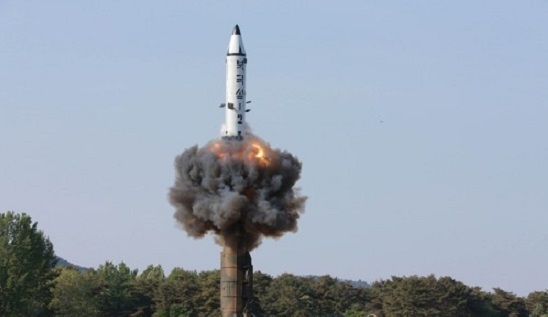NK defies international pressure with missile launch
By Yeo Jun-sukPublished : May 29, 2017 - 16:18
North Korea fired at least one short-range ballistic missile into the East Sea on Monday, said South Korea’s military, in an apparent effort to demonstrate its advanced ballistic missile capability and use it as leverage for potential negotiation over the regime’s nuclear program.
The suspected Scud-type missile lifted off at 5:39 a.m. from the North’s coastal city of Wonsan and flew at least 450 kilometers, according to Seoul’s Joint Chiefs of Staff. The Japanese government said the missile landed in the country’s exclusive economic zone, but there was no report of damage in the area.
Coincided with an ongoing joint navy drill and a scheduled US missile defense exercise, the launch was Pyongyang’s latest effort to advance its missile capability designed to develop a nuclear-tipped intercontinental missile and disrupt South Korea’s anti-missile system, military officials and analysts said.
The suspected Scud-type missile lifted off at 5:39 a.m. from the North’s coastal city of Wonsan and flew at least 450 kilometers, according to Seoul’s Joint Chiefs of Staff. The Japanese government said the missile landed in the country’s exclusive economic zone, but there was no report of damage in the area.
Coincided with an ongoing joint navy drill and a scheduled US missile defense exercise, the launch was Pyongyang’s latest effort to advance its missile capability designed to develop a nuclear-tipped intercontinental missile and disrupt South Korea’s anti-missile system, military officials and analysts said.

The third missile launch since the inauguration of President Moon Jae-in, the test also put pressure on Moon, known to be soft on the communist regime, to craft a concrete strategy to rein in the North‘s military threats as the international community ratcheted up condemnation on Pyongyang’s latest missile launches.
“Our analysis of (North Korea’s) intention is to demonstrate its commitment to building nuclear and missile capability based on its own roadmap and put pressure on our government to shift its policy toward North Korea," JCS spokesperson Col. Roh Jae-cheon said in a press briefing.
Although there was no immediate comment from North Korea and the allies have yet to figure out the exact type of missile used, there was speculation that the missile might be the Scud-C type with a range of 500 kilometers capable of reaching almost all parts of the peninsula.
Given that there were no Scud-type missiles being deployed at the Wonsan launch site, some analysts suggested that the launched missile could be a revised version of a Scud-type missile targeting US aircraft carriers deployed here, including USS Carl Vinson, which has participated in joint military exercise with South Korean Navy since April.
In a statement released after the launch, the US Pacific Command said that it had detected and tracked a short-range missile for six minutes until it landed in the East Sea, adding that the missile did not pose a threat to the US mainland.
Cheong Wa Dae convened a National Security Council meeting earlier in the day to discuss the North’s launch. The meeting was hosted by presidential security chief Chung Eui-yong and attended by newly appointed deputy NCS chiefs and the ministers of defense and foreign affairs.
In a statement, the JCS warned North Korea’s repeated provocation would further deepen its international isolation. The Foreign Ministry issued a separate statement, denouncing the test as defiance of the international community’s commitment to denuclearization of the peninsula.
Top nuclear envoys of South Korea, the US and Japan echoed condemnation against the North, describing the launch as “reckless and "persistent” provocation. The three envoys pledged to seek a stern measure, including a step from the UN Security Council.
The Ministry of the Unification also called for a stern response to the North’s provocation, but made clear that the ministry will continue its efforts to engage with Pyeongyang, including a policy review of whether to renew civil exchange between the two Koreas
“As far as the North’s missile tests, the foreign and defense ministries have delivered their condemnation,” ministry spokesperson Lee Duck-haeng said in a press briefing, noting that the condition for inter-Korean talks will also be considered an “equally important” issue.
Since the beginning of this year, North Korea has boasted advanced missile capability by firing a total of nine missiles with diverse capabilities in engine and range. Among them were the medium-range, solid-fueled Pukguksong-2 fired May 21 and the intermediate-range, liquid-fueled Hwasong-12 fired a week earlier.
Hwasong-12 is assessed to have ICBM-level ability capable of reaching Hawaii and Alaska. Pyongyang claimed that the missile was capable of carrying a “large-size, heavy nuclear warhead” to a target on the US and had come through “the worst re-entry situation” and struck its intended target.
Preparing for the North Korean ICBM capability, the Pentagon will conduct for the first time a missile defense drill designed to shoot down an ICBM heading for the US mainland. The drill is expected to take place as early as Tuesday.
By Yeo Jun-suk (jasonyeo@heraldcorp.com)


![[Exclusive] Korean military set to ban iPhones over 'security' concerns](http://res.heraldm.com/phpwas/restmb_idxmake.php?idx=644&simg=/content/image/2024/04/23/20240423050599_0.jpg&u=20240423183955)

![[Graphic News] 77% of young Koreans still financially dependent](http://res.heraldm.com/phpwas/restmb_idxmake.php?idx=644&simg=/content/image/2024/04/22/20240422050762_0.gif&u=)



![[Pressure points] Leggings in public: Fashion statement or social faux pas?](http://res.heraldm.com/phpwas/restmb_idxmake.php?idx=644&simg=/content/image/2024/04/23/20240423050669_0.jpg&u=)









